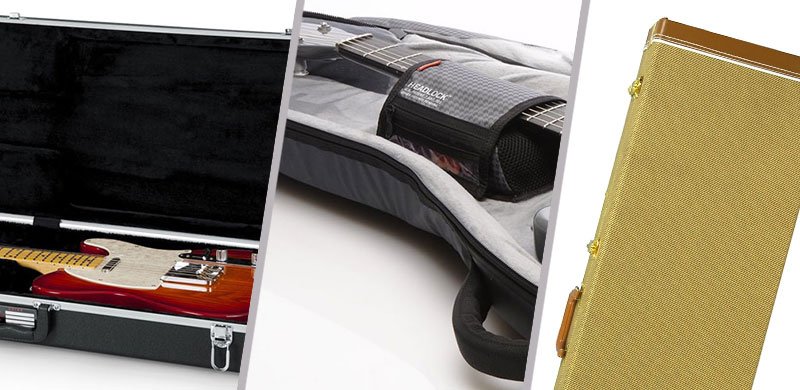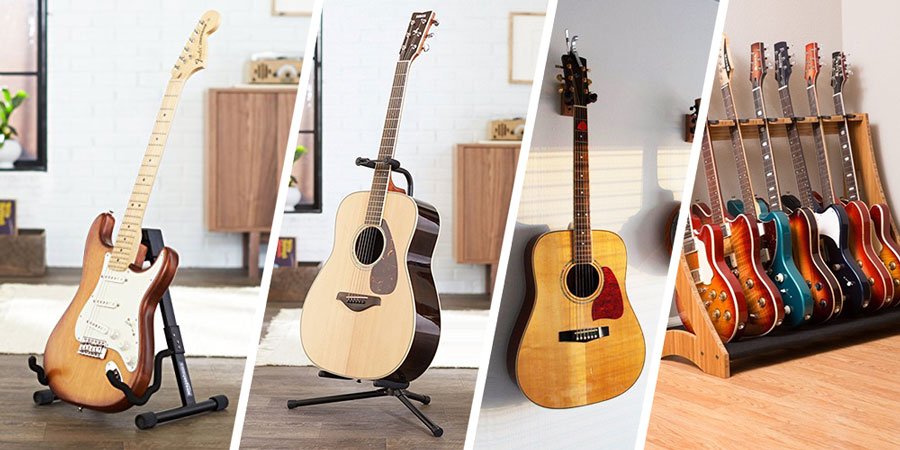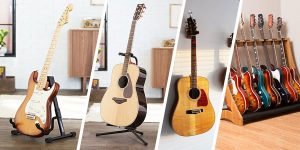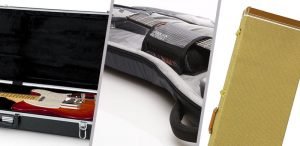Everyone starts out as a beginner guitar player, and so did I. I know well that finding the right accessories for your guitar is tough. You want to be sure you have everything necessary to get started playing guitar, without overdoing it.
But where do you start?
That’s why I’m here: To give newbies an overview of must-have (and good-to-have) guitar accessories, so they don’t miss anything on their path toward becoming a rock star.
Contents
Essential guitar accessories you need
Here is a list of the most important accessories you’ll want to get. These are absolutely necessary and will help you on your learning journey.
Guitar Tuners
A guitar tuner is an essential tool for any guitarist, beginner, or experienced. It’s the first thing you should have in your accessory kit. Without it, all that time spent learning chords and songs will just sound off-key – yikes.

Basically, a guitar tuner helps keep our guitars sounding their best by ensuring they are “in tune” (aka when each string of the instrument produces its correct note/pitch).
There’re several types of electric tuners out there:
- Clip-on acoustic models which attach directly to your headstock,
- Pedal units with displays so you can see what notes you’re playing at a glance
- Plus apps are available for smartphones too.
For those starting out on their musical journey, I recommend opting for either one of these two entry-level options: The GuitarTuna app, which does a decent job of correcting your tuning and is always with you 🙂
If you want to think of the future and are into electric guitars, the KLIQ TinyTune Tuner Pedal has excellent accuracy across multiple instruments complete with a bright LED display easy calibration settings as well as power supply included making it a great value buy overall.
Alternatively, if want something more lightweight my pick would be Snark SN5X Clip On Guitar Tuner also very accurate but comes at a cheaper price point than the former choice.
Whatever route you decide to take always double-check tuning once in a while before strumming away.
Guitar Strings
Guitar strings make up the heart of your instrument and they need to be in good shape if you’re going to get the proper sound out of them. With that being said, it is also important for beginners to have some spare new strings on hand just in case one break or wears down too much.
This will save you a lot of time and money when something goes wrong with your strings as opposed to having to buy a new set every time this happens.

There are different types of guitar strings available depending on what type of instrument you play: acoustic, electric, bass…etc.. For example – acoustic guitars typically use thicker gauge steel-stringed sets while electric guitars can benefit from thinner nickel-plated ones since these provide more flexible tones and sounds. So no matter which style playing – there’s definitely something perfect for everyone’s needs.
When choosing strings for beginner players should look into factors such as material (e.g., brass vs stainless steel), flexible coatings/windings (for jazzier options) gauges thickness ( i.e., light .009-.042; medium .011-.050; heavy .012”–054″).
Personally, I recommend starting off with lighter gauges first ’till you gain a little bit of experience then gradually increase tension towards medium thickness, then finally consider heavier gauges only after other aspects of your technique become comfortable.
Heavy gauge steel strings provide a lot of base, but they are harder to play on.
My personal recommendation for beginners would be:
- Electric guitar: Ernie Ball 2403 Super Slinky Nickel Wound Electric Guitar Strings (.009 – 042) – They provide great tone quality plus durability all within an affordable price range making them an ideal choice, even among many pros like myself included.
- Acoustic guitar: Martin guitar strings
TIP: Getting a string cleaner helps lengthen the life of your string. Use it after every session.
Guitar Picks
When it comes to guitar accessories, one of the most important items you can get are picks, also called plectrum.

Depending on how much force you like to use when strumming and picking strings, having a few different types around is really helpful for all kinds of playing styles. When selecting which type of pick works best for your style – whether celluloid, plastic or metal – there’s definitely some factors worth considering before making that final decision.
For starters: thickness. Generally speaking, thinner gauges offer more flexibility in terms of sound but require lighter touch; whereas thicker ones give a consistent tone with heavier downstrokes (which may be preferred by certain players who have developed stronger hands). The shape also makes an impact – from teardrop-shaped designs suitable for jazz sessions to triangular models designed especially with lead players in mind…the possibilities here seem endless.
As someone who has been teaching music forever, I’ve seen many beginners come up against this dilemma without ever finding the right fit initially so my advice would always be to try out multiple options until something clicks into place…every journey starts somewhere after all. Once they’ve found their ideal choice then those same learners often go back time & again because experience tells them exactly what they want – despite starting off slightly overwhelmed at times 😉
I always get Dunlop picks, they feel the best to me when playing.
Capo
Guitar capos are a must-have for beginners looking to progress their playing. A capo is like an extra finger that helps you play in different keys without having to learn all the new chord shapes – it’s almost magical.
It clips across your guitar neck, shortening or ‘shorting’ (as I call it) the length of strings so they can be played higher up the fretboard and produces a different pitch when strummed.
This means you get access to advanced chords much faster than if learning them normally would take months – what could be better?
Here is a list of the best guitar capos you can get in 2025.

There are two main types of guitar capos:
- Trigger style which requires one hand only
- Clamp type which clamps onto your guitars with two hands.
Both styles help shorten multiple strings at once, making life easier as there’s no need to think about individual string lengths each time. When choosing between these models consider ease of use on stage plus portability depending on where/when gigs have been booked into. Also, think about overall durability based on the material used; light plastic may not last long but heavier metal materials will stand the test of more vigorous performances over longer periods.
For beginner purposes, my recommendations include Shubb Capos for its lightweight design combined with affordability coupled with Kyser Quick Change Guitar Capo whose robust construction makes even heavy-handed players feel secure during any performance setting imaginable.
Guitar Case / Gig Bags
When investing in one of these protective carriers for your instrument, you’ll want something that is reliable and offers adequate protection while still being easy enough to transport around with you.
Here are my recommended acoustic guitar cases, and also the electric guitar cases that are good.

In terms of cases versus bags – they both serve their purpose but offer different levels of security;
- hardshell cases are typically sturdier and provide better shock absorption
- soft shell/gig bags tend to be lighter weight as well as easier on the wallet.
A personal favorite feature I’ve had great luck with though has been backpacks built specifically for guitars – perfect if you plan on doing traveling gigs or just taking your guitar to your friend’s house.
Depending on what type (acoustic or electric) and size (3/4-sized guitars have specific requirements) guitar body shape yours is will depend upon which cover works best: curved cutaways like Stratocasters need roomy bodied forms so opt-out from anything too snug fitting here. Also, take into consideration pockets and zipper compartments — these are extremely handy for storing strings, picks etc.
Additionally, some come preloaded with shoulder straps which makes life much simpler.
But with all that said, if you have a vintage or expensive guitar, you should definitely get a hard case to protect it.
Instructional Materials
I can’t stress the importance of having instructional materials when learning guitar enough. The phrase “practice makes perfect” is true but only if you practice correctly.

Reading books or watching videos about music theory, technique, and songs gives your playing a focus that will keep you motivated to learn more on your own. No matter what style of music you play there are tons of resources available for purchase online or from local musical instrument stores.
When selecting instructional material consider these factors:
- format (books, DVDs/videos),
- difficulty level (beginner through advanced)
- price range;
- as well as teacher compatibility – someone who speaks in terms and concepts that make sense to YOU.
A good way to tell if a product suits YOUR needs it by reading reviews either written by fellow students OR listening/watching previews prior to purchasing said product(s).
In my opinion, some great starting points for newbies include:
- Hal Leonard Essential Elements series which offers comprehensive book-and-CD packs with instruction geared towards various instruments including ukulele, bass guitar etc.
- GuitarTricks offers the best courses for beginners, this is my No. 1 recommendation
- JustinGuitar free course containing over 200 video tutorials providing excellent coverage in every area intended for beginners up until intermediate levels
- And don’t forget YouTube where any musician worth his salt has uploaded hours of teaching all kinds of topics.
So much information out there, waiting for just a few clicks away… Wowzers!
Speaking personally though I’m especially partial towards online lessons myself. I feel that learning music by seeing someone do it on video, reading about the lesson, getting the complimentary material, etc. is the next best thing to having a tutor there to hold your hand.
Good to have guitar gear
And as I promised, here are a few guitar accessories that are definitely good to have, but you don’t absolutely need them. At least for a while.
Instrument Cables for Electric Guitars
You can technically play an electric guitar without plugging it into a guitar amp, but there is no point.
When it comes to guitar playing, having a good guitar cable can be the difference between sounding great and being lost in the mix. Cables carry your signal from your guitar or bass to an amplifier; without one there’s no sound. And while they might not seem like that big of a deal at first glance, trust me when I say quality makes all the difference here – you don’t want any rustling noises or crackles interfering with those sweet licks.

There are three main types of instrument cables: straight (or unbalanced), angled (or XLR), and coiled.
- Straight is what most beginners start off using as it’s usually cheaper than other options – but if possible consider investing in something better as soon as you can afford it – even if just for time-saving convenience later on down the line; after all nobody wants their sultry solos broken up by static interference midway through them do they?
- Angled ones offer more noise shielding so tend to produce slightly crisper results overall. However, some people find that songs recorded with these have less warmth compared to others…if this sounds familiar then maybe give coiled ones a go instead.
- Coiled cables boast superior sonic clarity over longer distances, and are a premium choice, but probably overkill if you are a beginner.
No matter which type suits best I’d definitely recommend looking out for features such as reinforced rubber jacketing surrounding each connector plus gold-plated plugs/sockets where applicable – doing so will ensure both longevity & audio integrity throughout your future gigs & recordings alike.
Guitar Stand
Guitar stands like these are an incredibly useful accessory for any guitarist – beginner or otherwise. It is a piece of guitar gear you don’t technically need, but you should have it nonetheless.

Not only do they give you a convenient place to store your guitar safely when it’s not in use, but having one also makes playing much more comfortable. Plus, if you’re planning on performing live with your axe anytime soon, a sturdy and reliable stand is essential. Where else would you keep your guitar at a gig?
When choosing which type of stand will best suit your needs as a beginner musician there are several things to consider. You’ll want something that adequately supports the body shape and weight of whatever instrument(s) you have so be sure to read up about those specifications before making purchasing decisions—no need for surprise surprises here.
Additionally, factor in portability (for gigs or practice locations away from home), stability (will my heavy-handed strumming knock this thing over?), protection against scratches/dents, etc., and aesthetics if desired.
- A popular choice amongst beginning players who primarily play at home is one of many A-frame designs available. These tend to provide excellent support while remaining relatively compactable given their folding capabilities when collapsed down between uses – perfect room savers too.
- Tripod models work well both indoors & outdoors depending on what kind you get. Be careful though, some can easily become unstable.
- And lastly, you’ve got wall-mounted options for a home or a studio: although “slightly” less portable than others, they don’t risk getting knocked around like freestanding ones could. They are great even within cramped rehearsal spaces where floor space may be limited yet vertical surfaces still remain open.
Metronome / Drum machine
A metronome and/or drum machine can be essential tools in a guitarist’s toolbox. Metronomes have been around since the early nineteenth century, helping musicians keep perfect time while playing music together or practicing alone by providing an audible click at regular intervals (typically measured in beats per minute). Drum machines allow guitarists to create digital backing tracks with drums, percussion, and other sounds that they can play along with.
When learning new pieces of music on guitar it is important to start off slow before gradually increasing your tempo as you develop proficiency. Having access to either a drum machine or metronome allows for this gradual increase so that eventually you will master every section correctly – even when there isn’t anyone else around. It’s also great if you ever need help keeping up during band practice – just set your chosen device into ‘tap-tempo’ mode where each press of a button adjusts the speed accordingly – much easier than trying desperately counting out loud.
Having said all this though, I do prefer working without any kind of timing aid from time to time; some exercises are best practiced free form until muscle memory takes over, making sure my fingers hit exactly the right spot at precisely the correct moment within whatever piece I’m tackling next.
Still having one nearby may come in handy… just saying.
Guitar maintenance accessories
Good guitar maintenance is essential to keep your instrument in top shape. Cleaning materials and a quality guitar maintenance kit are two must-have accessories for any guitarist.
Cleaning materials will help you remove dirt, dust, sweat, and oils from the fretboard or strings after each use – trust me when I say that these can make all the difference to both sound quality and playability over time.
If nothing else – buy yourself some good quality cloth; cleaning with microfibre cloth has never done my axe wrong. Clean each freat, each string, the neck and the body of the instrument after each session. Your guitar will thank you.
Music sheet stand
Nowadays, you’ll be doing lots of learning from your computer monitor or smartphone. It is 2025 after all.
But it never hurts to have a music sheet stand at home, otherwise, you might hurt your neck trying to look at your music sheets on your bed.
Guitar Strap
As a beginner, you’ll probably be practicing sitting down most of the time. I’m here to tell you though, that if you only learn to play sitting, you’ll have a hard time transitioning to playing while standing. Trust me, been there, and done that.
You need a guitar strap to play standing up. There are loads of designs to choose from, it’s a lot of fun picking one out.
Frequently Asked Questions Guitar Accessories
WHAT ARE THE MUST-HAVE GUITAR ACCESSORIES FOR A BEGINNER?
The must-have guitar accessories for a beginner include a tuner, capo, strap, cable, guitar case, and guitar picks.
WHAT IS A GUITAR TUNER?
A guitar tuner is a tool used to help tune your guitar to the correct pitch. It can be a standalone device or a built-in feature in an electric guitar.
WHAT IS A CAPO?
A capo is a device that you can place on the neck of the guitar to change the pitch of the open strings. It helps you play in different keys without having to relearn the chords.
WHY DO I NEED A GUITAR STRAP?
A guitar strap keeps your guitar steady while playing standing up. It helps you focus on playing the guitar rather than holding it in place.
DO I NEED AN ELECTRIC GUITAR TO USE THESE ACCESSORIES?
No, these accessories can be used with both acoustic and electric guitars.
WHAT IS THE DIFFERENCE BETWEEN ELECTRIC GUITAR ACCESSORIES AND ACOUSTIC GUITAR ACCESSORIES?
Although many accessories can be used for both types of guitars, there are some specific accessories designed for electric or acoustic guitar. For example, an amp is only necessary for an electric guitar while a capo is used more frequently for an acoustic guitar.
DO I NEED A GUITAR STAND?
A guitar stand is not a must-have accessory, but it can keep your guitar in good shape by providing a safe and secure place to store it.
WHAT CAN BE INCLUDED IN A GUITAR TOOL KIT?
A guitar tool kit can include tools such as screwdrivers, pliers, wrenches, and fret files. These tools help you keep your guitar in good condition and make minor repairs if necessary.
CAN GUITAR ACCESSORIES MAKE IT EASIER TO PLAY?
Yes, having the right accessories can make it easier to play the guitar. For example, having a strap can help you play standing up, and having a capo can make it easier to play in different keys.
In conclusion
When it comes to playing the guitar, having a good collection of strings, tuners, and picks is essential – but they’re just the start.
As I’ve outlined in this article, there are plenty more must-have guitar accessories for beginners looking to make their musical mark on the world.
From top-notch instrument cables and instructional materials to metronomes/drum machines and cleaning kits – no matter what your skill level or budget may be; you’ll need these items if you want an edge over every other player out there. So go ahead: get yourself kitted up with all that’s necessary (and maybe even some cool extras too) so nothing can stand between you and rockin’ stardom.



